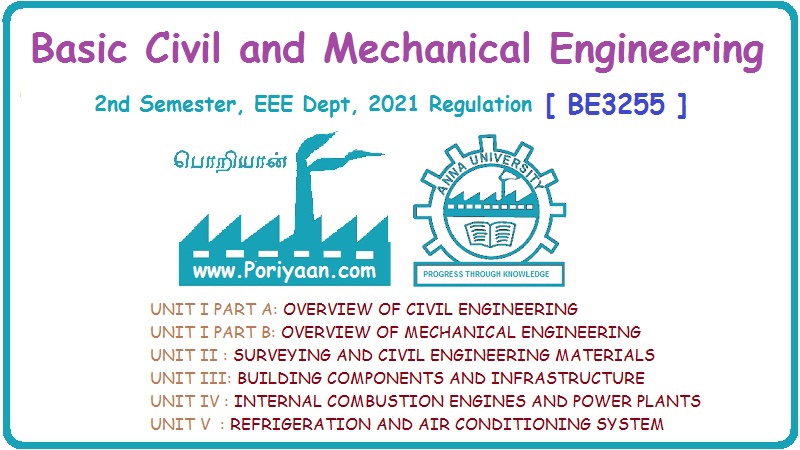Basic Civil & Mechanical Engineering: UNIT I: b. Structural engineering
Structural engineering
Overview of civil engineering
1. INTRODUCTORY CONCEPTS, 2. BASIC ISSUES IN THE DESIGN AND ANALYSIS OF STRUCTURES, 3. MECHANICS
UNIT – I
Chapter – 1 (A)
STRUCTURAL ENGINEERING
STRUCTURAL ENGINEERING - AN OVERVIEW
1. INTRODUCTORY CONCEPTS
Structural
engineering is a field of civil engineering which focuses on the design of
structures to withstand the loads and remain safe, stable and secure throughout
their use. A structure, in a building context, is “a device for channeling
loads that results from the use or presence of the building in relation to the
ground”. The study of structures involves many important and varying concerns.
The fundamental concern is to understand the basic principles that define and
characterize the behavior of physical objects subjected to forces.
2. BASIC ISSUES IN THE DESIGN AND ANALYSIS OF STRUCTURES
In
structures, the applied forces can cause the form to slide or overturn as a
whole or to collapse internally. Alternatively, components could break apart or
deform badly. The forces causing overturning or collapse come from the specific
environmental or use context (e.g., from the effects of wind, earthquake or
occupancy) or from the self-weight of structure itself. The above external
forces produce internal forces in a structure that results in development of
stresses. Civil engineers are expected to analyse and check the safety of
structures. This check involves determining the stresses developed at critical
locations and comparing them with the strength of the material used. The
material could be wood, steel, concrete etc. Engineers ensure that the stress
developed in structures is always less than the strength of the material for
safety.
Another
fundamental consideration in designing a structure is that of assuring its
stability under any type of loading condition. All structures undergo some
changes in shape under load. In a stable structure, the deformations induced by
the load are typically small. Further, the internal forces generated by the
action of the load tend to restore the structure to its original shape after
the removal of load. By contrast, unstable structure does not generate internal
forces that tend to restore its structure to its original configurations.
Thus,
it is the fundamental responsibility of a structural engineer to assure that
the proposed structure is (i) safe based on strength and (ii) stable with
deformations within the acceptable limits. The application of mechanics enables
the structural engineer to assemble elements, such as beams and columns, into a
structure that will resist both static and dynamic loads, such as gravity,
wind, snow and earthquakes.
3. MECHANICS
Mechanics
is the branch of physical science. It deals with the state of rest or state of
motion of bodies under the action of forces.
Archimedes
(287–212 BC), Galilio (1564–1642), Sir Issac Newton (1624–1727) and Einstein
(1878–1955) have contributed a lot to the development of mechanics. Substantial
contributions have also been made by Varignon, Euler, D'Alembert and others.
Basic Civil & Mechanical Engineering: UNIT I: b. Structural engineering : Tag: : Overview of civil engineering - Structural engineering
Related Topics
Related Subjects
Basic Civil and Mechanical Engineering
BE3255 2nd Semester 2021 Regulation | 2nd Semester EEE Dept 2021 Regulation
